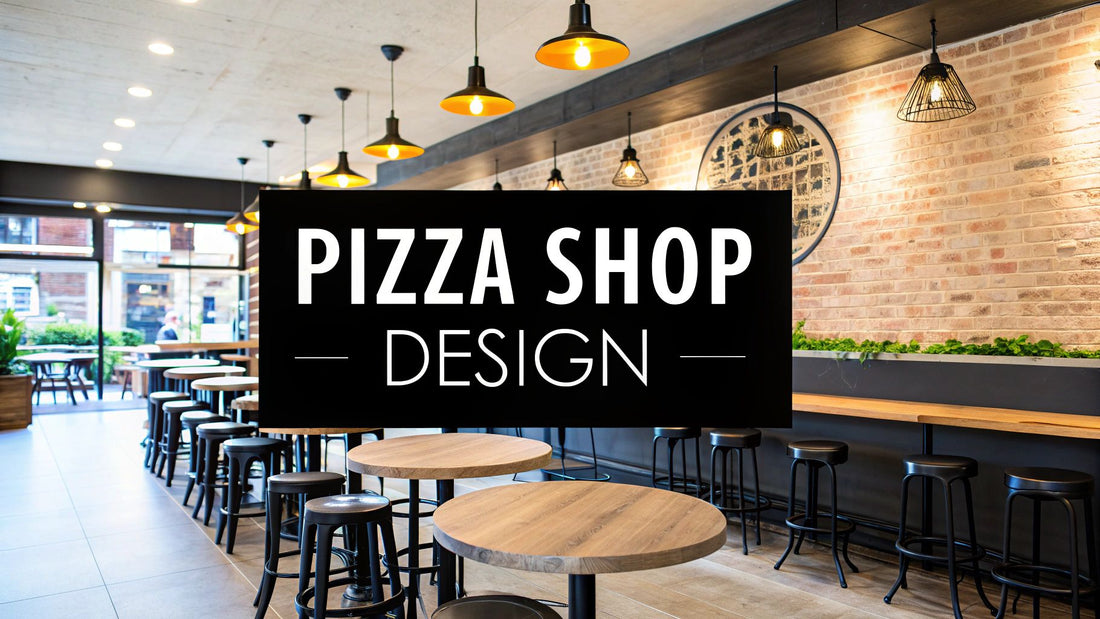
Creative Pizza Restaurant Design Ideas to Attract Customers
Share
In the competitive world of pizza restaurants, an exceptional pie is only half the battle. The other half is creating an unforgettable atmosphere that keeps customers coming back. The right design isn't just about aesthetics; it's a powerful business tool that shapes customer perception, streamlines workflow, and ultimately boosts your bottom line. From the moment a customer walks in, your restaurant's design tells a story about your brand, your quality, and the experience they can expect. A well-planned layout, for instance, ensures your pizza prep tables are positioned for maximum efficiency, improving service speed and staff comfort.
This guide dives into seven distinct and actionable pizza shop design ideas, each tailored to create a unique and memorable dining environment. We will explore specific themes, from the raw appeal of industrial chic to the cozy charm of a rustic farmhouse kitchen, providing practical insights to help you build a pizza restaurant that's as compelling as your menu. Whether you're launching a new venture or renovating an existing space, these concepts will help you craft an interior that supports your operations and captivates your customers, turning first-time visitors into loyal regulars.
1. Industrial Chic Pizza Restaurant Design
The Industrial Chic aesthetic is a powerhouse among modern pizza shop design ideas, celebrated for its ability to create an atmosphere that feels both historic and coolly contemporary. This style embraces the raw, functional beauty of a building's bones, transforming utilitarian elements into central design features. It's characterized by exposed brick walls, visible HVAC ductwork, polished concrete floors, and the prominent use of materials like steel, iron, and reclaimed wood. The result is an urban, edgy vibe that feels authentic and unpretentious, making customers feel like they've discovered a hidden gem.
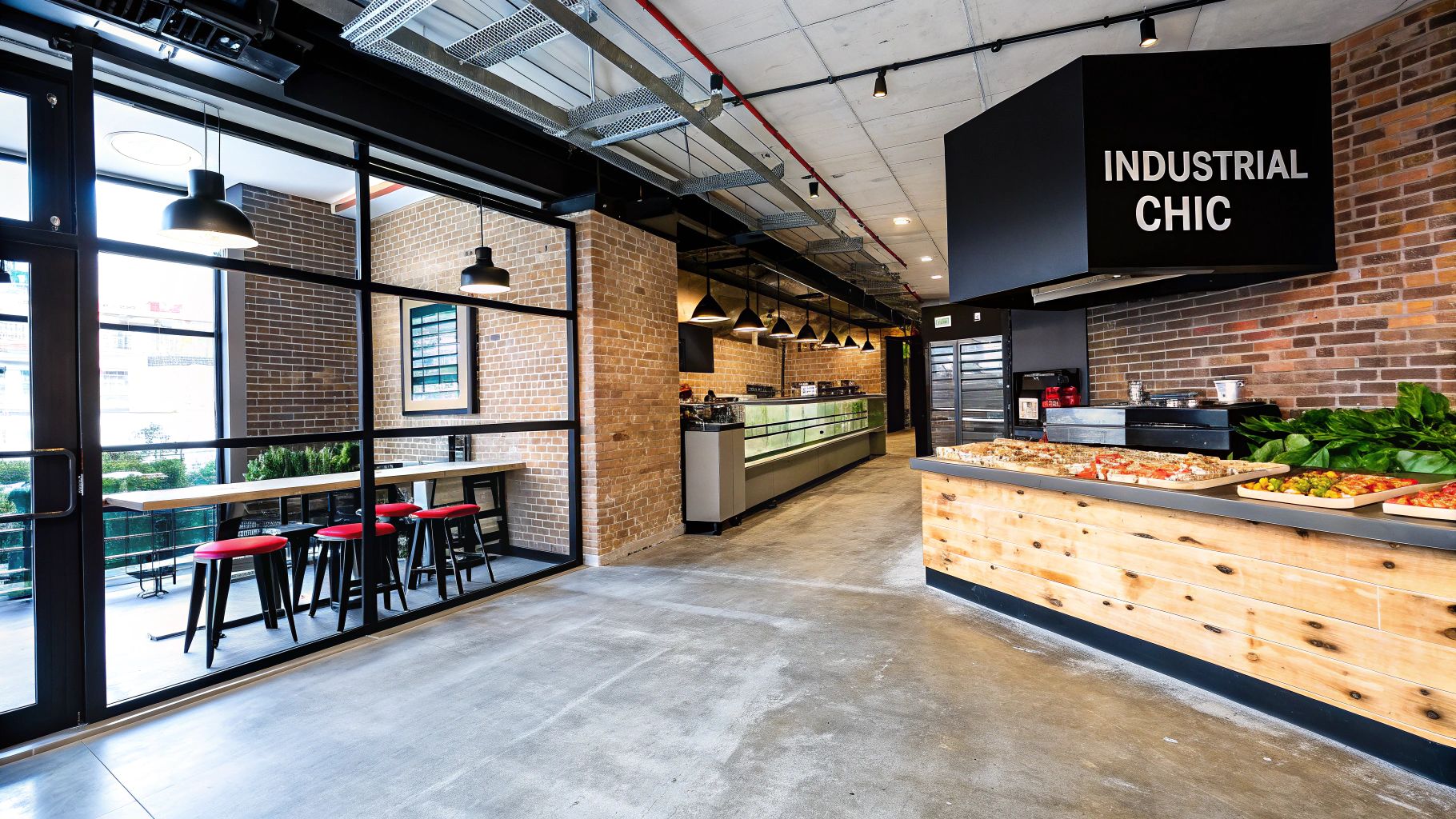
Popularized by influential pizza restaurants like Roberta's Pizza in Brooklyn, this design connects the dining experience to the craft of pizza making. It’s a perfect backdrop for showcasing the artistry of your chefs, especially when your pizza prep tables and ovens are integrated into an open-concept kitchen. The unfinished, workshop-like feel reinforces a message of quality craftsmanship and transparency.
How to Implement Industrial Chic
Achieving this look is about balancing hard and soft elements. You don't want your pizza restaurant to feel cold or unwelcoming.
- Balance Materials: Pair hard surfaces like concrete and steel with warm, natural elements. Use reclaimed wood for tabletops, bar tops, and seating to add warmth and texture. A sleek stainless steel pizza prep table can be beautifully contrasted with a rustic brick wall behind it, making it a functional centerpiece.
- Strategic Lighting: Lighting is critical. Use vintage-style Edison bulbs in pendant fixtures or track lighting to highlight specific areas like tables or the ordering counter. This creates intimate, warm pools of light within the larger, open space. Dimmers are a must-have to transition the mood from a bright lunch spot to a cozy evening destination.
- Soften with Greenery: Incorporate potted plants, hanging ferns, or a small herb garden to add life and color. Greenery breaks up the monochromatic palette of grays, blacks, and browns, preventing the space from feeling too stark.
- Acoustic Management: Exposed hard surfaces can create an echo. Address this by installing acoustic panels disguised as modern art or by using upholstered seating and heavy drapery in select areas to absorb sound without compromising the aesthetic.
2. Authentic Italian Trattoria Style
The Authentic Italian Trattoria style is one of the most timeless pizza shop design ideas, aiming to transport customers straight to a warm, family-run pizza restaurant in Italy. This design prioritizes comfort, heritage, and a sense of community, creating an atmosphere that feels both genuinely welcoming and steeped in tradition. It's defined by rustic materials like dark wood and terracotta tiles, warm color palettes of reds, yellows, and earthy tones, and charming, traditional decor. The result is a cozy, intimate space where guests feel like part of the family, encouraged to linger over a meal.
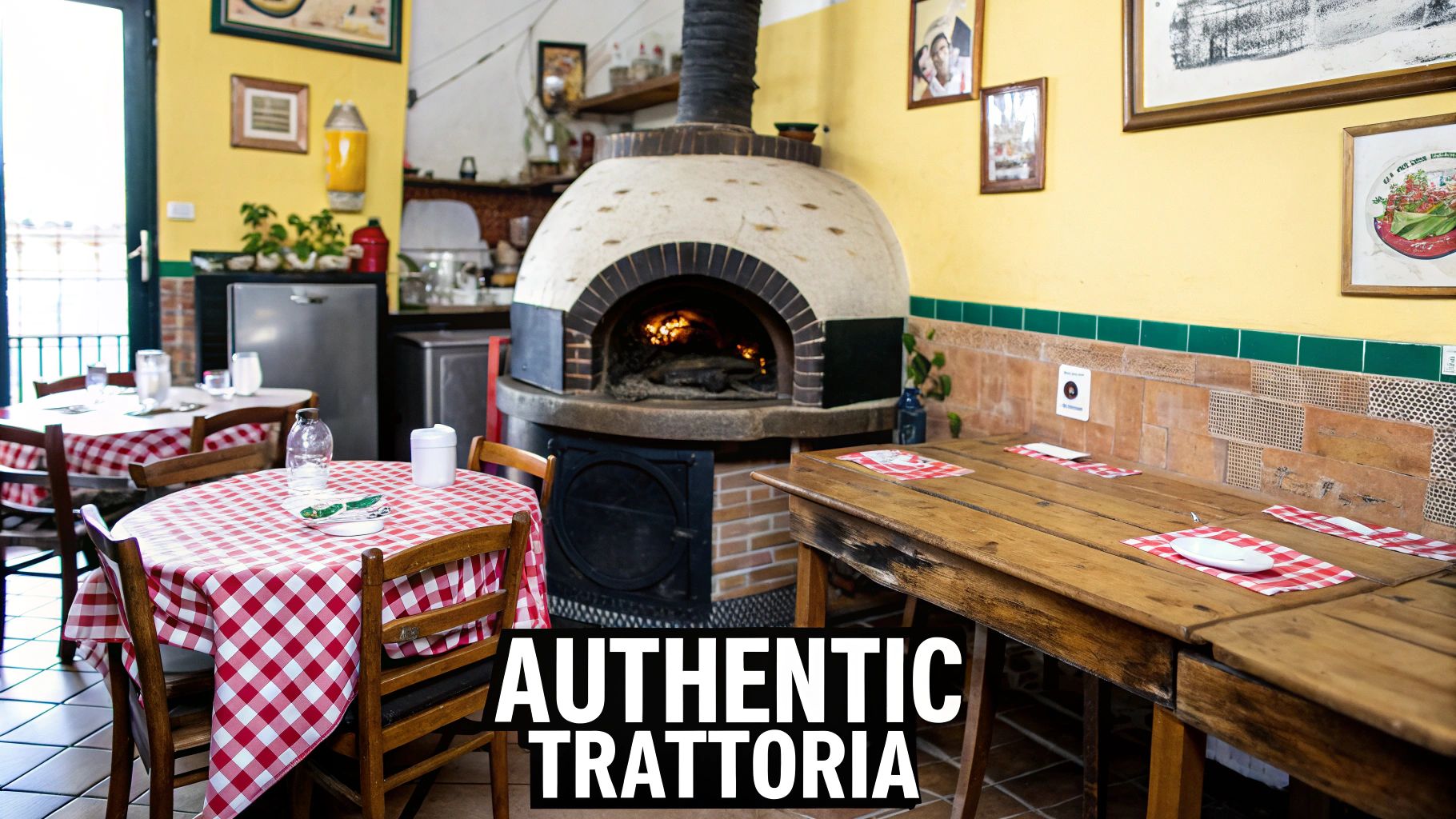
This classic aesthetic is embodied by legendary establishments like Lombardi's Pizza in NYC, America's first licensed pizzeria, which champions a no-frills, tradition-focused environment. The design is perfect for pizza restaurants that emphasize heritage recipes and classic techniques. Integrating your pizza prep table into a semi-open kitchen allows customers to see the authentic process, reinforcing the connection between the food and the rich culinary history your restaurant represents.
How to Implement Authentic Italian Trattoria Style
Achieving this look means focusing on details that evoke warmth and a sense of history. You want the space to feel lived-in and loved.
- Embrace Rustic Materials: Use dark, solid wood for tables, chairs, and bar tops. Terracotta or checkered black-and-white tile floors are classic choices. Plastered walls in warm tones like ochre or deep red can be accented with exposed brick sections for added texture.
- Create Intimacy with Lighting: Warm, ambient lighting is key. Use wrought-iron chandeliers, wall sconces, and candles on tables to create a soft, inviting glow. Avoid harsh, bright overhead lights. The goal is a cozy, romantic setting that feels comfortable for both families and couples.
- Decorate with Purpose: Use decor to tell a story. Display wine bottles in wooden racks, hang bunches of dried herbs, and showcase jars of olives and peppers. Framed vintage posters, family photographs, or scenes of Italy add a personal, authentic touch that makes the space feel unique.
- Showcase Your Pizza Ingredients: Let your quality ingredients become part of the decor. A well-placed wooden hutch displaying imported Italian cheeses, cured meats, and bags of "00" flour near the pizza prep area can serve as both a visual feature and a testament to your authenticity.
3. Modern Minimalist Design
The Modern Minimalist approach is one of the most sophisticated pizza shop design ideas, championing the philosophy that "less is more." It creates an upscale, refined dining environment by focusing on clean lines, uncluttered spaces, and the inherent beauty of high-quality materials. This design strips away non-essential elements, allowing the pizza and the customer experience to take center stage. The result is a calm, intentional atmosphere that feels both contemporary and timeless, communicating a message of premium quality and precision.
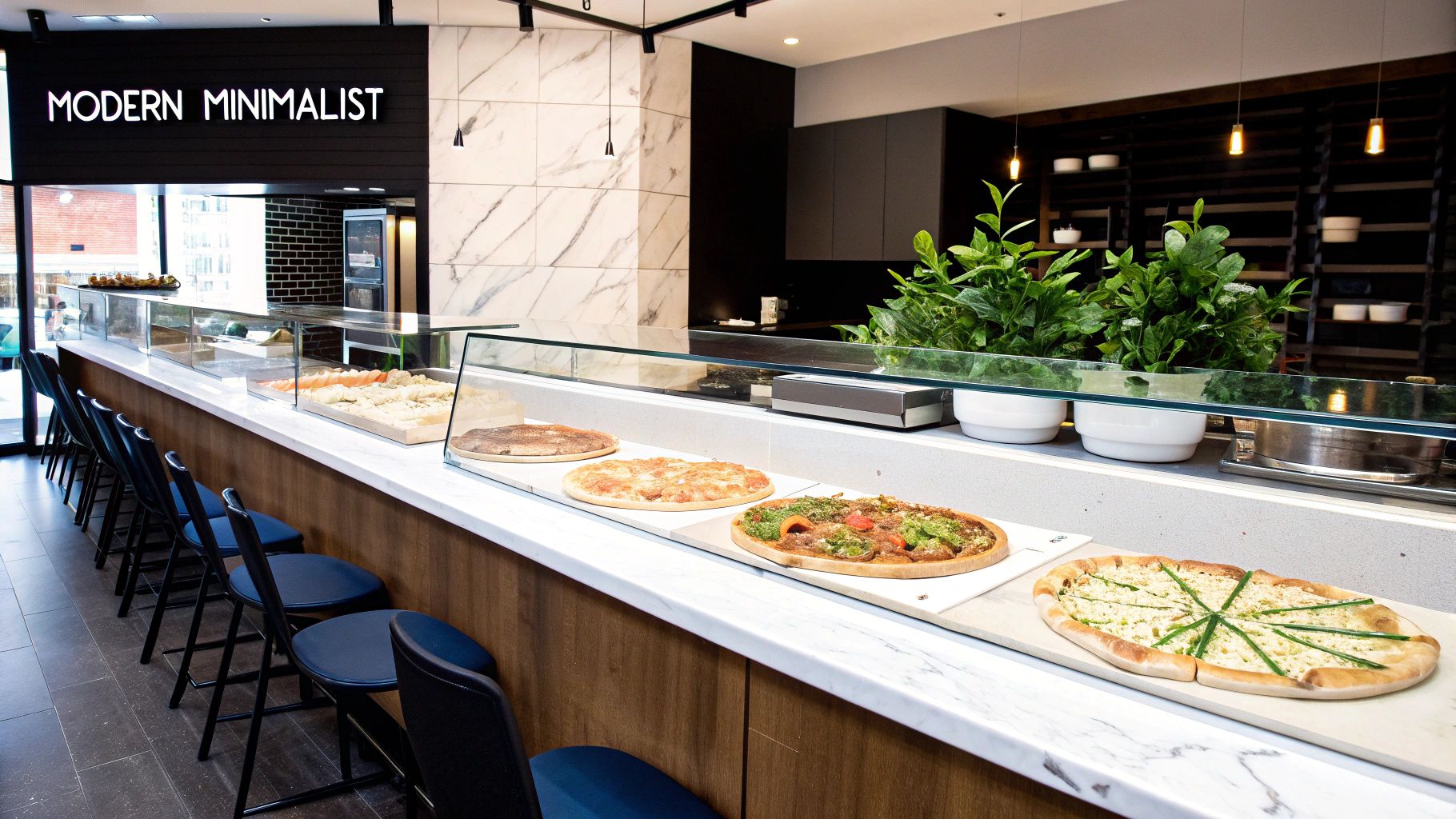
Popularized by the principles of Scandinavian and modern architecture, this aesthetic has been masterfully adapted by pizza restaurants like Pizzana in Los Angeles. This style is perfect for brands that want to elevate the perception of pizza from a casual bite to a culinary art form. By integrating a gleaming, streamlined pizza prep table into a pristine, open kitchen, you showcase your craft in a setting that reflects meticulous attention to detail.
How to Implement Modern Minimalism
Success with this style depends on thoughtful curation and a focus on subtle details that create warmth and prevent the space from feeling sterile.
- Embrace Texture Over Clutter: With a neutral color palette of whites, grays, and beiges, texture becomes crucial for adding depth. Use materials like light-grained wood for tables, smooth finished concrete for floors, and perhaps a subtly textured tile for the wall behind the counter. This adds visual interest without creating clutter.
- Strategic Use of Color and Light: A minimalist space doesn't have to be devoid of color. Introduce a single, bold accent color through chairs, a piece of art, or branding elements. Lighting is also a primary design tool. Use recessed track lighting, elegant pendant lights, and natural light to create a warm, inviting glow that highlights the clean architecture.
- Focus on Furniture and Greenery: Select furniture with simple, clean lines but prioritize comfort. Uncomfortable seating can undermine the entire experience. Use well-chosen plants or a single large Fiddle Leaf Fig tree as the primary form of decoration. Greenery adds a vital, organic element that softens the clean lines and brings life into the space.
- Functionality is Key: Every element must have a purpose. Your layout should be intuitive, guiding customers from the entrance to the counter to their seats effortlessly. The focus on functionality extends to your pizza kitchen, where an organized and visible pizza prep table can become a piece of performance art.
4. Vintage Americana Pizzeria
The Vintage Americana Pizzeria design is a heartfelt nod to the golden age of American pizza restaurants, spanning from the 1950s to the 1980s. This nostalgic approach creates a fun, casual, and family-friendly atmosphere by using retro elements like checkered floors, vinyl booths, and neon signage. It taps into a powerful sense of community and comfort, reminding patrons of classic neighborhood pizza parlors where birthdays were celebrated and high school sports victories were cheered. It’s a design that feels both familiar and exciting, appealing to multiple generations.
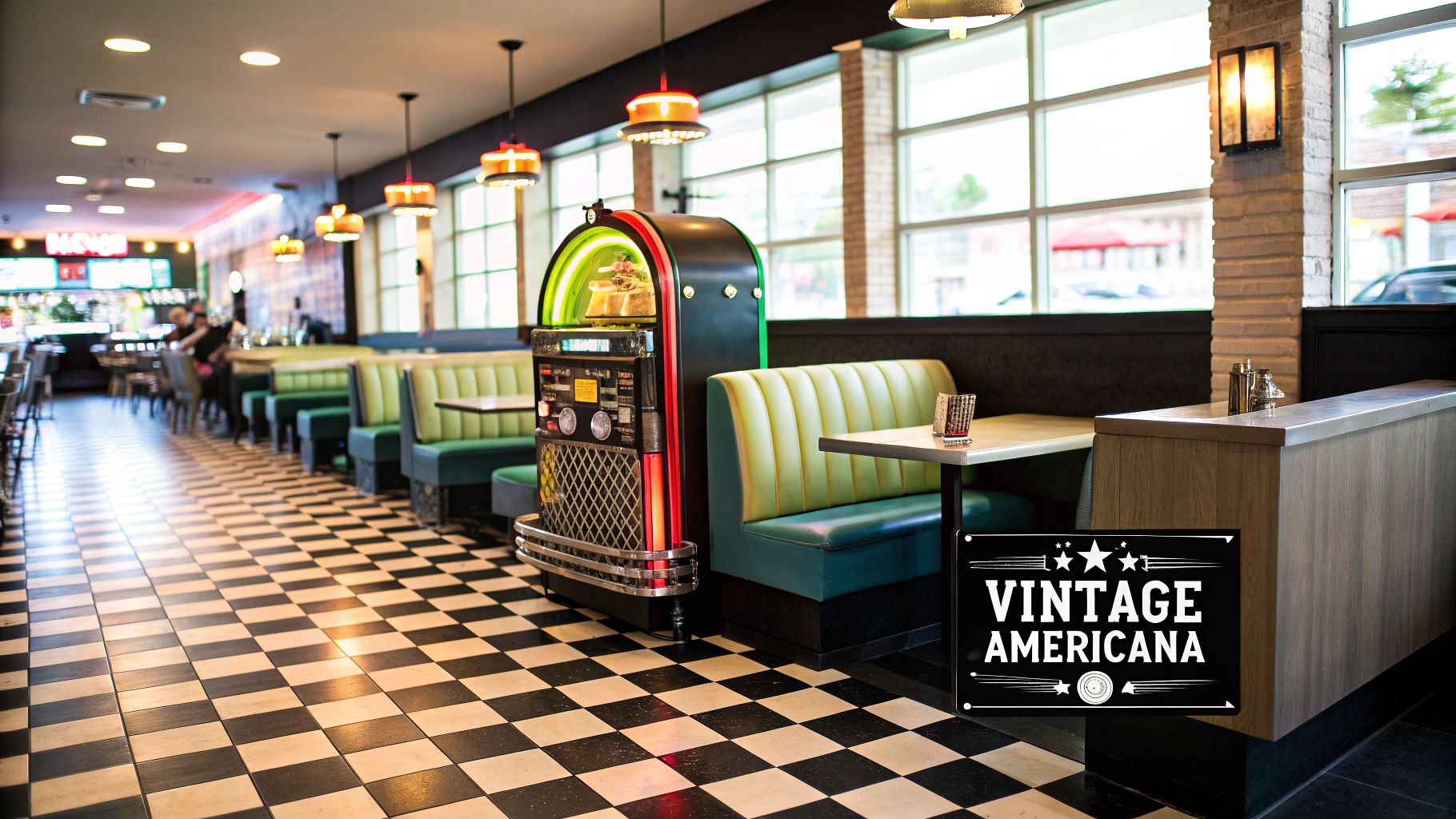
This style was popularized by the post-WWII American diner boom and later cemented by chains like Shakey's Pizza. The aesthetic is about more than just looks; it's about creating an experience. It evokes a simpler time centered around straightforward, delicious pizza and good company. Integrating classic arcade games or a jukebox can enhance this theme, turning a meal into a memorable outing. This design is one of the most effective pizza shop design ideas for operators targeting families and community groups.
How to Implement Vintage Americana
Successfully creating this vibe means blending nostalgia with modern functionality and comfort. It's about curation, not clutter.
- Curate, Don't Collect: Blend authentic vintage finds with high-quality reproductions. Scour antique shops for genuine Coca-Cola signs or period-correct gumball machines, but opt for new, durable vinyl for your booth seating. This ensures reliability without sacrificing the classic look.
- Create Entertainment Zones: Designate specific areas for different activities. Keep the dining and ordering areas distinct from a small arcade or game corner. This manages foot traffic and noise levels, allowing some guests to enjoy a quieter meal while others engage in entertainment.
- Display with Style: While an open kitchen is less common in this style, you can use retro-style display cases for desserts or sides. A well-chosen case can fit the theme perfectly while boosting impulse buys.
- Balance Nostalgia with Modern Needs: While the theme is retro, your pizza kitchen operations shouldn't be. A sleek, modern pizza prep table can be cleverly integrated behind a classic-style counter, ensuring your team can work efficiently without breaking the vintage illusion for the customer. Ensure the space is clean, well-lit, and comfortable, avoiding the worn-down feel of an old establishment.
5. Fast-Casual Counter Service Design
The Fast-Casual Counter Service design is a masterclass in efficiency, tailored for pizza restaurants that prioritize speed, customization, and high customer turnover without sacrificing atmosphere. This approach streamlines the customer journey from the moment they enter, guiding them through a clear, intuitive ordering process. It’s characterized by an assembly-line format, prominent digital menu boards, and a mix of seating designed for both quick bites and slightly longer stays. The result is a vibrant, modern environment that meets the demands of today's consumer for speed and personalization.
Pioneered by brands like Chipotle and perfected within the pizza space by chains such as Blaze Pizza and MOD Pizza, this design puts the "show" in the pizza-making process. The open-concept counter, often featuring an expansive pizza prep table, allows customers to watch as their custom creation is built, fostering transparency and engagement. This model is exceptionally well-suited for high-traffic locations where quick service is paramount, turning the operational necessity of speed into a compelling customer experience.
How to Implement Fast-Casual Counter Service Design
Success with this model hinges on creating a seamless and logical customer flow that prevents bottlenecks and confusion.
- Design a Clear Customer Path: The layout should naturally guide customers from the entrance, along the ordering line, to the payment station, and finally to the pickup area. Ensure the pizza prep table is the star of the assembly line, allowing customers to easily point out ingredients as their pizza moves down the line.
- Leverage Digital Menus: Use bright, easy-to-read digital menu boards to display options, pricing, and promotions. This allows for instant updates and can feature enticing videos or images of your pizzas, which helps speed up the ordering decision process.
- Offer Flexible Seating & Amenities: Accommodate different types of diners. Include high-top tables for solo diners or quick meals, communal tables for groups, and a few comfortable booths. Providing accessible power outlets, charging stations, and free WiFi adds significant value and encourages repeat business.
- Optimize Your Cooking Technology: Speed is crucial. While a traditional pizza oven is the centerpiece, integrating high-speed cooking solutions is vital. For example, some fast-casual concepts use high-speed ovens to quickly finish pizzas without slowing down the main production line.
6. Rustic Farmhouse Pizza Kitchen
The Rustic Farmhouse pizza kitchen design evokes a sense of warmth, comfort, and homemade quality. This aesthetic is all about creating a cozy, inviting atmosphere that feels like a welcoming country home, perfectly complementing the artisanal, farm-to-table movement. It relies heavily on natural materials like weathered wood, stone, and wrought iron, combined with soft textiles and vintage-inspired decor. The result is a space that feels genuine and wholesome, assuring customers of fresh, thoughtfully prepared pizza.
Popularized by the broader rustic chic design trend and championed by pizza restaurants that emphasize local sourcing, like some Harvest Pizza locations, this style connects diners to the origins of their food. It’s an ideal setting for showcasing fresh ingredients and traditional pizza-making techniques. A pizza prep table with a butcher block top or rustic wood enclosure becomes a centerpiece, reinforcing the message of authentic, hands-on craftsmanship. The entire environment communicates a story of quality and care from the farm to the oven.
How to Implement a Rustic Farmhouse Look
Achieving an authentic farmhouse feel means focusing on texture, natural elements, and details that suggest a lived-in history. It's about being intentionally imperfect and comfortable.
- Embrace Natural & Reclaimed Materials: Use reclaimed barn wood for wall paneling, tabletops, or ceiling beams. A stone-clad accent wall behind your pizza oven adds a powerful, earthy focal point. Pair these with durable, practical surfaces where needed, such as a stainless steel pizza prep table that provides a modern, hygienic workspace within the rustic frame.
- Use Soft, Warm Lighting: Avoid harsh, modern lighting. Instead, opt for wrought-iron chandeliers, pendant lights with seeded glass shades, or antique-style sconces. This creates a soft, ambient glow that enhances the cozy atmosphere and makes the space feel intimate and friendly, perfect for families and date nights.
- Incorporate Functional Decor: Decor should feel purposeful. Use Mason jars for drinking glasses or to hold wildflowers. Display fresh ingredients like braided garlic, hanging herbs, or baskets of tomatoes and peppers prominently near the pizza prep table. This not only adds color and life but also reinforces your commitment to freshness.
- Comfortable & Mismatched Furniture: Choose sturdy, wooden furniture that prioritizes comfort. Don't be afraid to mix and match chair styles or use long, communal farm tables to encourage a shared dining experience. Bench seating with comfortable cushions can add to the relaxed, family-style vibe.
7. Open Kitchen Concept Design
An Open Kitchen Concept is one of the most engaging pizza shop design ideas, transforming the functional act of cooking into a captivating performance. This design breaks down the walls between the kitchen and the dining area, positioning the pizza-making process as the restaurant's main attraction. By making the culinary craft the focal point, you create a dynamic atmosphere of theater and transparency that builds customer trust and enhances the overall dining experience. It’s a powerful way to communicate freshness, skill, and a passion for pizza.
This trend has been embraced by successful pizza restaurants like Pizzeria Mozza in Los Angeles, which leverage the spectacle of dough tossing and fresh ingredient assembly to entertain guests. The open kitchen isn’t just a layout; it’s a statement about your commitment to quality. When customers see the care put into their food, from the arrangement of toppings on a gleaming pizza prep table to the pie being carefully placed in a wood-fired oven, it deepens their connection to your brand.
How to Implement an Open Kitchen Concept
A successful open kitchen is meticulously planned to be as functional for staff as it is entertaining for guests.
- Spotlight the Action: Use strategic lighting, like focused spotlights or pendant lamps, to draw attention to key areas of the pizza-making process. Illuminate the dough-stretching station, the topping assembly on the pizza prep table, and the mouth of the oven to create dramatic focal points.
- Design for Viewing: Create designated viewing areas so guests don't feel like they are in the way. A bar-height counter facing the kitchen is a classic solution, offering a front-row seat. Consider adding a lower counter or a glass partition so children can safely watch the pizza show.
- Manage Heat and Sound: Proper ventilation is non-negotiable to manage smoke, heat, and odors. High-capacity hoods are essential. To combat noise, incorporate sound-dampening materials like acoustic ceiling tiles, upholstered banquettes, or decorative wall panels to keep the dining area comfortable. For more on creating a functional workspace, you can explore the secrets behind efficient pizza prep stations.
- Train Staff for the Stage: Your pizza kitchen team is now on display. Train them not only on culinary execution but also on maintaining a clean and organized workspace and interacting positively, even non-verbally, with observing customers. Their professionalism becomes a core part of the customer experience.
7 Pizza Restaurant Design Styles Comparison
| Design Style | Implementation Complexity 🔄 | Resource Requirements 💡 | Expected Outcomes 📊 | Ideal Use Cases 💡 | Key Advantages ⭐ |
|---|---|---|---|---|---|
| Industrial Chic Pizza Restaurant | Moderate – requires balance of raw materials and lighting | Moderate – durable materials, maintenance needed | Urban, edgy atmosphere; photogenic and cost-effective | Modern urban demographics, social media focused | Cost-effective; durable; authentic atmosphere |
| Authentic Italian Trattoria | High – needs consistent theming and authentic elements | High – premium authentic materials | Warm, family-friendly, emotionally engaging | Families, traditionalists, premium experience seekers | Strong emotional connection; timeless design |
| Modern Minimalist Design | High – needs perfect execution and quality materials | High – premium materials like marble and glass | Sophisticated, upscale, clean environment | Upscale, design-conscious customers | Timeless aesthetic; easy maintenance; premium perception |
| Vintage Americana Pizzeria | Moderate – retro elements with maintenance of vintage items | Moderate – mix of vintage and reproductions | Nostalgic, fun, family-friendly, and entertaining | Family dining, comfort food lovers | Nostalgic appeal; distinctive branding; family-friendly |
| Fast-Casual Counter Service | Moderate to High – efficient flow and tech integration | Moderate – POS systems, flexible seating | Quick service, high turnover, scalable operations | Time-conscious customers, franchises | Operational efficiency; scalable; appeals to speed oriented customers |
| Rustic Farmhouse Pizza Kitchen | Moderate – sourcing authentic natural materials | Moderate to High – natural and reclaimed materials | Cozy, artisanal, comfort and farm-to-table appeal | Organic, farm-to-table, artisanal market | Strong emotional connection; photogenic; artisanal feel |
| Open Kitchen Concept | High – requires kitchen visibility, ventilation, training | High – professional equipment, sound control | Engagement, transparency, culinary entertainment | Restaurants focusing on culinary showmanship | Builds trust; entertainment value; premium experience |
Bringing Your Vision to Life: From Prep Table to Patron
We have journeyed through a diverse menu of compelling pizza shop design ideas, from the exposed brick and steel of Industrial Chic to the warm, checkered tablecloths of an Authentic Italian Trattoria. We explored the clean lines of Modern Minimalism, the nostalgic charm of Vintage Americana, the efficiency of Fast-Casual layouts, and the cozy appeal of a Rustic Farmhouse kitchen. Each of these design themes offers a unique narrative and a distinct way to connect with your customers before they even take their first bite.
However, a stunning storefront is only half the recipe for success. The true test of your pizza restaurant's design is not just how it looks, but how it functions. The most memorable customer experiences are born from a seamless fusion of captivating atmosphere and flawless operational execution. This is where your design philosophy must extend beyond the dining room and into the heart of your pizza kitchen.
Bridging the Gap Between Ambiance and Action
The critical link between your brand's aesthetic and your product's quality is your kitchen workflow. An Open Kitchen Concept, for example, brilliantly merges these two worlds, turning the act of pizza creation into a form of entertainment. But even in a closed kitchen, the principles of smart design are paramount. Your layout must be an intuitive, well-oiled machine built for speed, consistency, and staff well-being.
The central hub of this machine is undeniably the pizza prep table. This single piece of equipment is where your culinary vision becomes a tangible, delicious reality. It is the stage upon which every single pizza is built, from stretching the dough and ladling the sauce to artfully arranging toppings.
Key Takeaway: An exceptional pizza restaurant is the product of a dual investment: one in a design that attracts and delights customers, and another in a functional kitchen that empowers your team to deliver on that promise with every order.
Actionable Next Steps for Pizzeria Owners
As you move from inspiration to implementation, focus on translating your chosen theme into a practical, operational blueprint.
- Map Your Workflow: Physically trace the journey of a pizza order, from the point of sale to the customer's hands. Identify every touchpoint, especially the critical path from the dough station, to the pizza prep table, to the oven, and finally to the cutting and boxing station.
- Prioritize Your Prep Line: The pizza prep table is not just a workspace; it is the engine of your entire operation. Its size, configuration, and refrigeration capacity must directly support your menu's complexity and your projected order volume. A bottleneck here will undermine even the most beautiful dining room.
- Integrate Form and Function: Ensure your equipment choices align with your aesthetic. For an open kitchen, a sleek, stainless steel pizza prep table can enhance a Modern or Industrial look. For a Rustic theme, you might build a custom enclosure around the unit using reclaimed wood or tile that matches your decor.
Ultimately, the most successful pizza shop design ideas are those that create a cohesive and immersive world for the patron while simultaneously building an efficient and ergonomic one for the staff. By thoughtfully selecting a design and backing it with a powerful, well-organized pizza kitchen, you set the stage for enduring success. You are not just building a restaurant; you are crafting an experience, one perfect pizza at a time.
Ready to build the functional heart of your pizza restaurant? The right equipment is the foundation of any great pizza shop design idea, and a high-quality pizza prep table is non-negotiable. Explore the durable, efficient, and versatile options at Pizza Prep Table to find the perfect model that will empower your team to bring your vision to life. Visit Pizza Prep Table to see how our solutions can anchor your kitchen's success.
